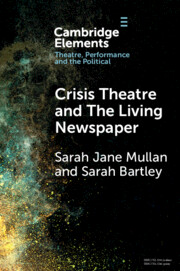263 results
2 - External Shocks
-
-
- Book:
- The Conservative Effect, 2010–2024
- Print publication:
- 27 June 2024, pp 37-70
-
- Chapter
- Export citation
6 - Performances of Suffering
-
- Book:
- Constructing Religious Martyrdom
- Print publication:
- 27 June 2024, pp 323-361
-
- Chapter
- Export citation
A qualitative study exploring the challenges for a national police force as first responders to children and young people presenting with mental health crises: perspectives of emergency department professionals
-
- Journal:
- Irish Journal of Psychological Medicine , First View
- Published online by Cambridge University Press:
- 04 June 2024, pp. 1-7
-
- Article
- Export citation
Chapter 13 - Classicism
- from Part II - Literature
-
-
- Book:
- Goethe in Context
- Published online:
- 16 May 2024
- Print publication:
- 23 May 2024, pp 121-129
-
- Chapter
- Export citation
Conclusion
- from Part III - Crisis and Morale
-
- Book:
- Making Sense of the Great War
- Published online:
- 11 April 2024
- Print publication:
- 18 April 2024, pp 282-296
-
- Chapter
- Export citation
5 - Hoping for Peace
- from Part III - Crisis and Morale
-
- Book:
- Making Sense of the Great War
- Published online:
- 11 April 2024
- Print publication:
- 18 April 2024, pp 197-231
-
- Chapter
- Export citation
6 - Experiencing Crisis
- from Part III - Crisis and Morale
-
- Book:
- Making Sense of the Great War
- Published online:
- 11 April 2024
- Print publication:
- 18 April 2024, pp 232-281
-
- Chapter
- Export citation
Epilogue
-
- Book:
- Politics of the Past
- Published online:
- 05 April 2024
- Print publication:
- 11 April 2024, pp 237-252
-
- Chapter
- Export citation

Making Sense of the Great War
- Crisis, Englishness, and Morale on the Western Front
-
- Published online:
- 11 April 2024
- Print publication:
- 18 April 2024
Introduction
-
- Book:
- Sharing Freedom
- Published online:
- 28 March 2024
- Print publication:
- 04 April 2024, pp 1-30
-
- Chapter
- Export citation
Chapter 10 - Government, Policy, and Censorship in Post-war British Theatre
- from Part IV - Theatre and State
-
-
- Book:
- The Cambridge Companion to British Theatre since 1945
- Published online:
- 14 March 2024
- Print publication:
- 21 March 2024, pp 209-228
-
- Chapter
- Export citation

Crisis Theatre and The Living Newspaper
-
- Published online:
- 12 March 2024
- Print publication:
- 11 April 2024
-
- Element
- Export citation
2 - Production, 1000–1500
- from Section II - The Medieval Economy, 1000–1500
-
-
- Book:
- An Economic History of the Iberian Peninsula, 700–2000
- Published online:
- 22 February 2024
- Print publication:
- 29 February 2024, pp 47-75
-
- Chapter
- Export citation
Gouvernance et démocratie fédérale en temps de crise : quelques leçons tirées de la pandémie de COVID-19 au Canada
-
- Journal:
- Canadian Journal of Law & Society / La Revue Canadienne Droit et Société / Volume 38 / Issue 3 / December 2023
- Published online by Cambridge University Press:
- 21 February 2024, pp. 372-390
-
- Article
-
- You have access
- Open access
- HTML
- Export citation
Competing Visions and Constitutional Limits of Schengen Reform: Securitization, Gradual Supranationalization and the Undoing of Schengen as an Identity-Creating Project
-
- Journal:
- German Law Journal ,
- Published online by Cambridge University Press:
- 20 February 2024, pp. 1-20
-
- Article
-
- You have access
- Open access
- HTML
- Export citation
4 - Independence(s): What Is a Revolutionary Law?
-
-
- Book:
- The Cambridge History of Latin American Law in Global Perspective
- Published online:
- 15 January 2024
- Print publication:
- 08 February 2024, pp 250-282
-
- Chapter
-
- You have access
- Open access
- HTML
- Export citation
1 - Introduction
-
-
- Book:
- Diversity and Precarious Work During Socio-Economic Upheaval
- Published online:
- 01 February 2024
- Print publication:
- 08 February 2024, pp 1-11
-
- Chapter
- Export citation
6 - Right-Wing Populism in the USA
-
- Book:
- Democracy's Resilience to Populism's Threat
- Published online:
- 11 January 2024
- Print publication:
- 25 January 2024, pp 196-226
-
- Chapter
- Export citation
7 - Conclusion
-
- Book:
- Democracy's Resilience to Populism's Threat
- Published online:
- 11 January 2024
- Print publication:
- 25 January 2024, pp 227-260
-
- Chapter
- Export citation
1 - The Populist Threat to Democracy
-
- Book:
- Democracy's Resilience to Populism's Threat
- Published online:
- 11 January 2024
- Print publication:
- 25 January 2024, pp 1-29
-
- Chapter
- Export citation



